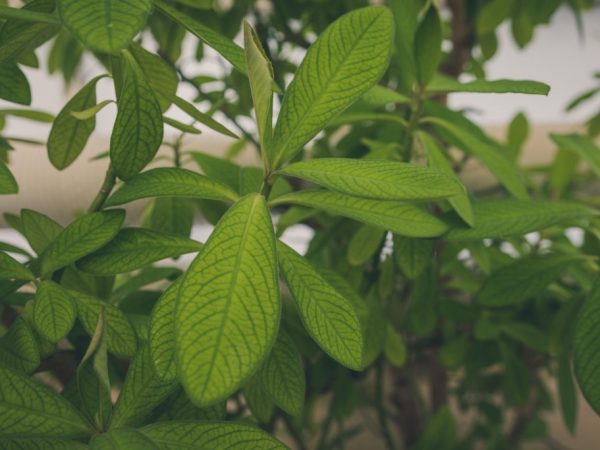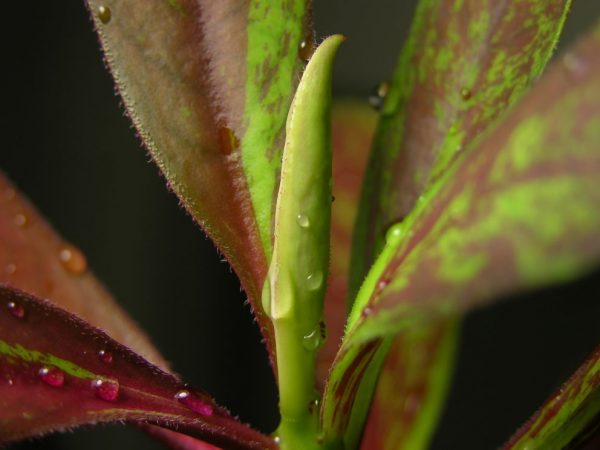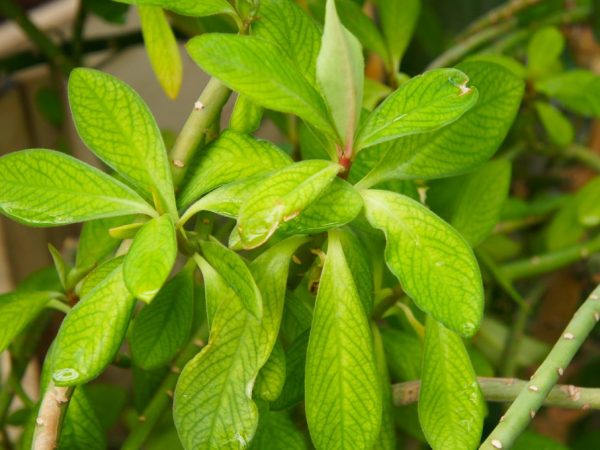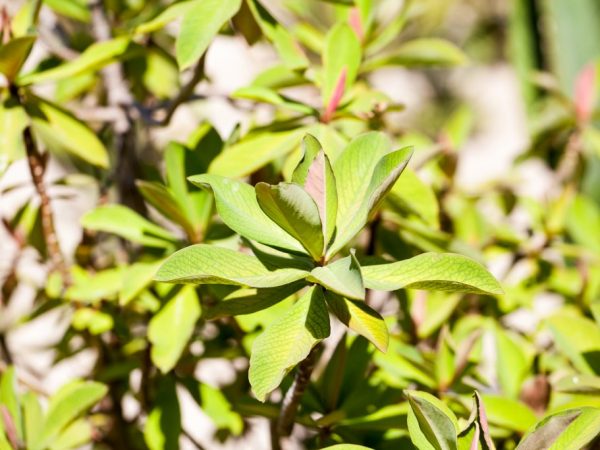Sinadenium - the intricacies of caring for an exotic tree
Synadenium Granta and Rubra are two popular home-grown milkweed varieties. The homeland is the tropics and subtropics of Africa. In the common people, the plant is called the tree of love. The culture received approval from florists for both its attractive appearance and unpretentiousness in care and cultivation.

Sinadenium - the intricacies of caring for an exotic tree
general characteristics
Sinadenium is a fairly massive tree, in nature capable of reaching a height of up to 3 m.Differs in rapid growth and development - the annual growth is 20-25 cm.
Refers to the number of succulents. The root system is branched, extending deep into the soil.
On the branches, rare erect processes are formed, which are characterized by a thickened structure, which allows the plant to adapt to adverse conditions during a drought. The surface is covered with a smooth rich green skin.
Leaves are dense, leathery, attached to short petioles. The shape is oval or obovate. They are located opposite or alternately.
Description of varieties
Grant
One of the most popular species, adapted for growing at home. It is represented by a branching shrub with a considerable number of side shoots.
The color is deep green, in rare cases, variegated. With the correct formation of the crown, it is possible to achieve the shape of a standard tree.
Rubra
A distinctive feature is burgundy leaves of irregular outlines. At a young age, they are pink. Flowering occurs in the winter. Peduncles are long, with red bell-type buds.
After flowering, it forms a tricuspid capsule with small black seeds. It blooms exclusively in the wild.
Landing rules
When the culture becomes cramped in the pot, this is clear from the external characteristics - the leaves wither and fall off.
A stable planter with drainage holes at the bottom is chosen as a new container.
Stages:
- A thick drainage layer is laid on the bottom of the container.
- Pour out half of the substrate.
- The plant is removed from the old pot, the partially earthen lump is carefully removed. Then they are placed in a prepared container and poured with soil so that about 1 cm remains from the edge.If necessary, to restrain growth, part of the roots is cut off.
All manipulations are carried out in protective gloves - the succulent secretes poisonous milky juice, which causes severe irritation of the skin and mucous membranes.
The necessary conditions
Microclimate
A succulent plant needs a lot of light. In this case, do not place it in a place exposed to direct sunlight, which contributes to the occurrence of burns. In this case, the plant should be shaded.
In the cold season, the culture is additionally illuminated with phytolamps.
A lack of lighting is the reason for a decrease in decorativeness - the leaves become lighter, internodes are extended.
The flower is quite capable of adapting to dry air even if the heating devices are working, therefore, it does not need to artificially maintain humidity.

Milkweed needs a lot of light
For sanitary purposes, you can wipe the surface with a damp cloth to remove dust accumulated on the leaves. In especially hot months, the plant is occasionally sprayed in the immediate vicinity so that moisture does not get on the shoots.
The optimum temperature during the growing season is 22-25 ° C. In winter, the indicators are reduced to 15 ° C.
Seat selection
It is possible to place palm euphorbia in almost any place, depending on which the content norms will differ.
If the pot is on a southern windowsill, it should be shaded when the sun is active; however, it will be most comfortable on the east or west side with soft light.
Soil selection
Succulent is not capricious to the composition of the soil. It develops well in a fairly loose, air-permeable substrate, which is characterized by a medium neutral in acidity.
To compose the soil mixture, they are independently mixed in equal parts:
- coarse sand;
- leafy ground;
- peat.
Additionally, wood ash is added, which acts as a protective barrier against root rot and pathogenic bacteria. Without fail, the bottom of the container is laid with drainage from expanded clay or clay shards.
Also, the soil can be supplemented with brick chips, which will ensure the maximum passage of moisture and prevent its stagnation.
Home care
Despite the fact that the culture is considered quite unpretentious in care, in order to maintain the decorative qualities of a flower, it needs to create the most favorable conditions for keeping.
This will not cause particular difficulties, if you do not take into account the active growth of the tree, due to which it becomes problematic to keep the exotic handsome man within the necessary framework without regular haircuts.
Watering
The procedure is carried out only as the top layer of the earthen coma dries out. The rest of the time, the earth is moistened with a spray gun 2 times a month.
If, after prolonged water starvation, the leaves began to wither, and the shoots wilted, it will not be possible to correct the situation by resuming watering. For this, it is recommended to arrest all injured segments, thus redirecting forces to the formation of new ones.
Fertilizers and feeding
Top dressing is done twice in each autumn and spring, when milkweed actively grows. As fertilizers, special compositions for cacti or complex preparations for decorative indoor flowers are used.

Fertilizers improve plant development
At the same time, it is recommended to reduce the concentration of the agent indicated on the label or add it in a small amount to the water for irrigation.
Transfer
Young specimens need frequent transplantation once a year. When the plant reaches 4-5 years old, the procedure is performed every 3 years. Activities are carried out before the start of active growth, in the first spring months.
When the synadenium becomes massive, only the upper part of the substrate is replaced.
Pruning
It is easy to form, which is allowed to be carried out regardless of the season. By pruning, you can achieve the shape of both a lush and a single-stemmed tree with a height of 2 m.If necessary, to suspend the growth of a succulent, pinch the shoots.
If the plant is grown as a shrub, shearing is necessary as it stimulates branching. For sanitary purposes, all dry and damaged processes are removed.
Reproduction methods
Cuttings
- Cut off shoots 10-15 cm long from the top of the shoots so that several leaf plates are present on them. The wounds are sprinkled with crumbs of activated carbon, then left to dry.
- After a film has formed on the cut, the cuttings are placed in a soil of sand and peat, previously disinfected by calcining in an oven, deepening by 2-3 cm.
- The container is placed in a well-lit place with a maintained temperature of 20 degrees. When the shoots take root, as evidenced by the emerging young shoots, they are transplanted. In this case, the substrate is replaced with a standard one for adult culture representatives.
Seeds
A more laborious process, mainly carried out by experienced flower growers. Manipulations are performed in the spring. A container with a sand-peat mixture is prepared, on the surface of which the seed is distributed. Sprinkle on top with a layer of sand of 1 cm and cover with glass, pre-moistened with a spray bottle.
After 2 weeks, when the first shoots appear, the cover is removed. When the seedlings reach a height of 10 cm, a primary pick is made. The subsequent procedure is carried out when the young grow up to 30 cm.
Diseases and pests

Sinadenium rarely gets sick
Sinadenium is a poisonous flower, and therefore it is extremely rarely exposed to an invasion of pests.
Most of the problems that growers face are the result of improper care and deviations from the growth rates.
| Leaf Symptoms | Cause of occurrence | Solution to the problem |
| Fall off | Fluctuations in temperature, decay of the root system, irregular watering, irrigation with cold water | They normalize the room temperature, systematize watering. The damaged segments are cut off, treated with a fungicide, and the plant is transplanted. |
| Loss of turgor | Moisture deficiency | Normalize the irrigation system |
| The shoots are stretched out | Insufficient lighting | Cropped, rearranged to a more illuminated place |
| Dry tips | Watering with hard water | Use settled water |
| Chlorosis | Lack of nutrients | Fertilize |
| Gray, sluggish leaves, white spiderweb | Spider mite | Treat with soapy water or acaricides (Aktellik, Karbofos). Normalize air humidity |
| Brownish-red bumps, sticky coating | Shield | Mechanically removed with a cotton swab dipped in an alcohol solution, isolated in quarantine, sprayed with Aktara. |
| White cotton-like lumps | Mealybug | As a preventive measure, you should systematically spray and wipe the leaves. With a slight lesion, it is treated with a solution of laundry soap, in critical situations - with Aktellik. |
Signs and superstitions
In connection with the milky juice contained in the shoots, the flower is dangerous to humans and can cause considerable harm to health, expressed in a strong allergic reaction or food poisoning.
However, succulent also brings benefits - its roots are often used to prepare various tinctures. Helps to cope with migraines, liver and stomach diseases, and relieves the symptoms of bladder inflammation.
There are no folk signs and superstitions associated with the synadenium, therefore, without a doubt, you can grow indoor euphorbia at home. However, it is not recommended to put exotics in the bedroom, due to the toxic juice.


